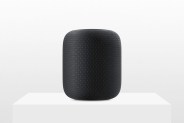What’s Happening: Apple’s HomePod, the company’s first smart speaker, was announced back in June with the promise of a December arrival. Apple didn’t deliver on that date, obviously, and those who had thought, by now, they’d be giving “Hey Siri” voice commands to their gorgeous new smart speaker were left in limbo — when would it be released? Well, Apple announced today that the HomePod can be preordered this Friday (January 26) and it’ll ship on February 9.
This announcement comes with a surplus of excitement, but also a touch of skepticism. This is the speaker that many people have been waiting for, after-all. It’s a hi-fi speaker (unlike the Amazon Echo and Google Home) that works seamlessly with the iPhone and MacBook you already own. You know how easy it is to pair your iPhone and AirPods together? The HomePod promises to deliver that ease but connecting all home sound and theater systems (if you have an Apple TV), while also controlling all your HomeKit-supported smart devices. For those heavily invested in the Apple ecosystem, this is the be-all-end-all of smart speakers.
You know how easy it is to set up AirPods? All signs point to more of the same with the HomePod.
Watch Out For: On the downside, however, Apple also revealed that the HomePod will not support multi-room audio at launch, and that’ll come as a free software update “this year.” This is a pretty big letdown, especially when you consider that the HomePod was originally supposed to go toe-to-toe with Sonos’s line of multi-room speakers (though, this was before Sonos announced its new Sonos One smart speaker). Also, there’s no exact date for this software update. That said, the multi-room update will eventually arrive and if you’ve waited this long to get the HomePod, you’re probably “OK” with waiting a little longer.
The HomePod will eventually be able to play in a multiroom setup with other AirPlay 2-supports speakers, by the likes of Bose, Devialet, Naim and Bang & Olufsen. Two HomePods in the same room will be able to work in a stereo pair, but this feature will come as a later software update, too. And at launch, Siri voice commands will only work for Apple Music subscribers. Support for Spotify subscribers will eventually come, but that date is also unknown.
Insight: The world has been ready for the HomePod for a while. There are tons of HomeKit-supported smart devices that will be able to be controlled it, and a number of existing speakers that are waiting for the AirPlay 2 firmware update (which I assume will come with Apple’s multiroom update). Yes, Apple is releasing a product that’s not as complete as originally anticipated, which is unlike Apple, but more interestingly, a question should remain if Apple felt pressured to announce the HomePod as a way to stave Echo or Sonos purchases. If so, it may have worked, but the market has responded by lowering prices, and as we all know, it’s hard to beat a lower price.


